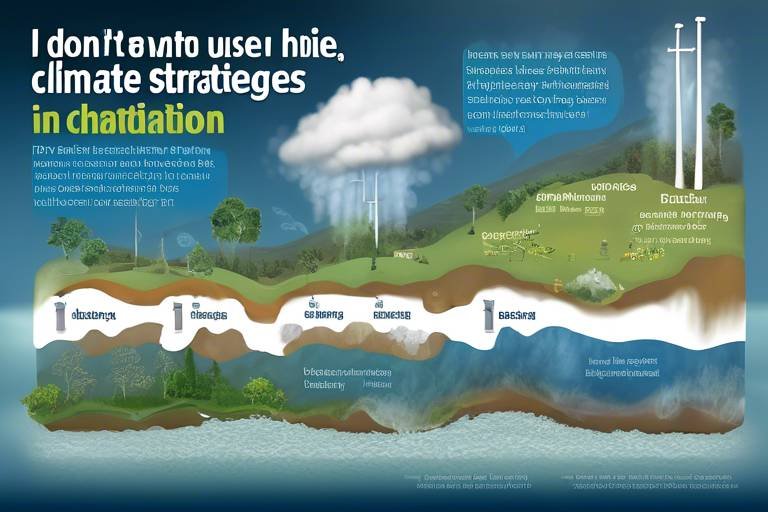The Role of Science in Addressing Climate Refugees
In today's rapidly changing world, the phenomenon of climate refugees is becoming increasingly prominent. These are not just abstract statistics; they are real people, uprooted from their homes due to the relentless forces of climate change. As scientists delve deeper into the complexities of this issue, they uncover critical insights that not only enhance our understanding but also pave the way for actionable solutions. The role of science in addressing the plight of climate refugees is multifaceted, encompassing research, data collection, and the development of innovative strategies aimed at alleviating suffering and fostering resilience.
At its core, scientific research provides the foundation for understanding the intricate relationship between climate change and human displacement. By employing rigorous methodologies, researchers can identify the specific environmental triggers that lead to migration. For instance, rising sea levels, extreme weather events, and prolonged droughts are just a few examples of how our planet's changing climate forces individuals and communities to seek refuge elsewhere. The implications of these displacements are profound, affecting not only the refugees themselves but also the regions that receive them.
Moreover, the scientific community plays a crucial role in informing policymakers and humanitarian organizations about the needs and challenges faced by climate refugees. With this knowledge, strategies can be developed that are not only effective but also sustainable. For instance, scientists are exploring how to create resilient infrastructure that can withstand environmental changes, ensuring that both refugees and host communities can thrive together.
In summary, the intersection of science and the climate refugee crisis is a vital area of study that demands our attention. Through innovative research and collaboration, we can better understand the challenges faced by displaced populations and work towards solutions that promote human dignity and environmental sustainability. As we dive deeper into this topic, let us explore the various dimensions of climate refugees, from their definition and causes to the scientific solutions that can support them on their journey toward a better future.
- What are climate refugees? Climate refugees are individuals who are forced to leave their homes due to environmental changes caused by climate change, such as rising sea levels, extreme weather, and droughts.
- How does science help in understanding climate refugees? Scientific research provides data and insights into the causes of climate displacement, helping to inform policies and humanitarian efforts aimed at supporting affected populations.
- What are some of the challenges faced by climate refugees? Climate refugees often encounter social, economic, and environmental challenges in host communities, including limited resources, cultural integration issues, and increased competition for jobs.
- What solutions are being developed to support climate refugees? Scientists are working on various solutions, including sustainable housing initiatives, community resilience strategies, and policy recommendations to support both refugees and host communities.

Understanding Climate Refugees
Climate refugees are individuals who find themselves in a dire situation, forced to leave their homes due to the relentless march of environmental changes. Imagine waking up one day to discover that your hometown, once a thriving community, has been transformed into a barren wasteland due to rising sea levels, extreme weather events, or prolonged droughts. This phenomenon is not just a distant possibility; it is a reality that millions face globally. These individuals are not merely displaced; they are uprooted from their lives, their cultures, and their communities, all because of factors that are often beyond their control.
The term "climate refugee" encompasses various scenarios where environmental degradation leads to forced migration. Some of the primary causes include:
- Rising Sea Levels: Coastal communities are increasingly vulnerable as oceans rise, swallowing homes and livelihoods.
- Extreme Weather Events: Hurricanes, floods, and wildfires have become more frequent and intense, displacing populations in their wake.
- Drought and Desertification: Prolonged dry spells lead to crop failures, pushing farmers to abandon their land in search of better opportunities.
The implications of climate-induced displacement are profound. Firstly, it creates a ripple effect, not just for the refugees but also for the communities that receive them. Host areas may experience increased pressure on resources such as water, housing, and healthcare. Moreover, the socio-economic fabric of these communities can be strained as they struggle to integrate newcomers who often bring different cultural backgrounds and needs.
Understanding climate refugees also requires acknowledging the intersectionality of this issue. Factors such as poverty, gender, and social status can exacerbate the vulnerabilities faced by displaced individuals. For instance, women and children often bear the brunt of climate impacts, facing heightened risks of violence and exploitation. In this context, climate change doesn't just create refugees; it amplifies existing inequalities, making it essential to approach the issue with a holistic perspective.
To truly grasp the scope of this crisis, we must also consider the numbers. According to the United Nations, it is estimated that by 2050, there could be as many as 200 million climate refugees worldwide. This staggering figure underscores the urgency of addressing the issue head-on. As we embark on this journey to understand climate refugees, it is crucial to recognize that they are not just statistics; they are real people with stories, dreams, and the right to a dignified life.
In summary, climate refugees represent a growing global challenge that necessitates immediate attention and action. By understanding their plight, we can begin to formulate effective responses that not only address their immediate needs but also contribute to long-term solutions for resilience and adaptation in a rapidly changing world.

The Science of Climate Change
Understanding the science of climate change is crucial in addressing the growing crisis of climate refugees. At its core, climate change refers to significant alterations in temperature, precipitation, and other atmospheric conditions over extended periods. These changes are primarily driven by human activities, notably the emission of greenhouse gases (GHGs) such as carbon dioxide (CO2) and methane (CH4), which trap heat in the atmosphere. As these gases accumulate, they lead to a phenomenon known as global warming, which has far-reaching consequences for our planet.
To grasp the full impact of climate change, it’s essential to recognize its direct effects on both ecosystems and human populations. For instance, rising global temperatures contribute to the melting of polar ice caps and glaciers, resulting in rising sea levels that threaten coastal communities. Additionally, increased temperatures can lead to more frequent and severe weather events, such as hurricanes, droughts, and floods, which can displace populations and disrupt livelihoods. The Intergovernmental Panel on Climate Change (IPCC) warns that without significant intervention, millions could be displaced by 2050 due to these environmental changes.
Moreover, the consequences of climate change are not uniform; they disproportionately affect vulnerable populations, particularly in developing countries. These communities often lack the resources to adapt to changing conditions, making them more susceptible to displacement. For example, smallholder farmers who rely on stable weather patterns for their crops may find their livelihoods threatened by unpredictable rainfall and extended droughts. This leads to a vicious cycle where economic instability forces individuals to migrate, often to urban areas that may not be equipped to handle the influx.
To illustrate the impact of climate change on displacement, let's look at some key statistics:
| Year | Number of Climate Displaced Persons (millions) | Major Causes |
|---|---|---|
| 2010 | 42 | Floods, storms |
| 2015 | 19 | Droughts, extreme weather |
| 2020 | 30 | Floods, wildfires |
As we delve deeper into the science of climate change, we must also consider the methodologies used to collect data on its impacts. Effective data collection is crucial for understanding the extent of climate displacement and informing policy responses. This includes a mix of quantitative data, such as satellite imagery that tracks environmental changes, and qualitative insights gathered from field surveys and interviews with affected populations. By integrating these approaches, scientists can create a more comprehensive picture of how climate change is reshaping human geography.
In conclusion, the science of climate change is a multifaceted field that encompasses various disciplines, from environmental science to social studies. Understanding the underlying principles is vital for developing effective strategies to support climate refugees and mitigate the impacts of displacement. As we continue to witness the effects of climate change unfold, it becomes increasingly clear that immediate action is necessary to protect those who are most vulnerable.
- What are climate refugees? Climate refugees are individuals who are forced to leave their homes due to environmental changes caused by climate change.
- What causes climate change? Climate change is primarily caused by human activities, including the burning of fossil fuels, deforestation, and industrial processes that release greenhouse gases into the atmosphere.
- How does climate change affect displacement? Climate change leads to extreme weather events, rising sea levels, and changes in agricultural productivity, all of which can force people to leave their homes in search of safety and stability.
- What can be done to help climate refugees? Solutions include providing humanitarian assistance, developing sustainable housing, and implementing policies that support integration and resilience in host communities.

Data Collection Methods
When it comes to understanding the plight of climate refugees, effective data collection is absolutely crucial. Think of it as the foundation of a house; without a solid base, everything built on top is at risk of crumbling. Scientists and researchers utilize a variety of methodologies to gather data that informs us about the experiences and challenges faced by these displaced individuals. Among the most prominent methods are remote sensing technologies and field surveys, each offering unique insights into the complex issue of climate-induced displacement.
Remote sensing technologies, for instance, involve the use of satellite imagery to monitor environmental changes across vast regions. This method allows researchers to identify areas that are at high risk of climate-induced migration due to factors like rising sea levels, desertification, and extreme weather events. With the ability to capture real-time data, scientists can track shifts in land use, vegetation cover, and even population density over time. This information is invaluable, as it helps policymakers and humanitarian organizations anticipate the needs of communities that may soon face an influx of climate refugees.
On the other hand, field surveys and interviews provide a more personal perspective on the issue. By directly engaging with climate refugees, researchers can collect qualitative data that highlights the human side of this crisis. These firsthand accounts are essential for understanding the emotional and psychological impacts of displacement, as well as the day-to-day struggles that individuals face in their new environments. For instance, a field survey might reveal that a family displaced by flooding not only lost their home but also their livelihood, which can lead to further complications like food insecurity and mental health issues.
Both methods complement each other, creating a more comprehensive picture of climate displacement. While remote sensing offers a broad overview of environmental changes, field surveys dig deeper into the personal stories behind the statistics. Together, they provide a robust framework for understanding the complexities of climate refugees' experiences. It's like piecing together a puzzle; each piece—whether it's a satellite image or a personal story—adds depth and clarity to the overall picture.
As we continue to explore solutions for climate refugees, it's essential to recognize the importance of these data collection methods. They not only inform humanitarian efforts but also guide policy decisions that can make a significant difference in the lives of those affected. By investing in both technological advancements and community engagement, we can better prepare for the challenges that lie ahead in a world increasingly shaped by climate change.
- What are climate refugees? Climate refugees are individuals who are forced to leave their homes due to environmental changes, such as extreme weather events, sea level rise, or drought.
- How do scientists collect data on climate refugees? Scientists use various methods, including remote sensing technologies and field surveys, to gather data on the experiences and challenges faced by climate refugees.
- Why is data collection important for climate refugees? Effective data collection helps inform humanitarian efforts, guide policy decisions, and create a comprehensive understanding of the complexities surrounding climate-induced displacement.
- What role do remote sensing technologies play? Remote sensing technologies allow researchers to monitor environmental changes and identify areas at risk of climate-induced migration through satellite imagery.
- How do field surveys contribute to understanding climate refugees? Field surveys provide qualitative insights by capturing personal stories and experiences, helping to highlight the emotional and psychological impacts of displacement.

Remote Sensing Technologies
Remote sensing technologies are revolutionizing the way we monitor environmental changes that lead to climate-induced migration. Imagine being able to observe the planet from above, capturing data that can predict where communities might be displaced due to rising sea levels or extreme weather events. This is precisely what remote sensing does. By utilizing satellites equipped with advanced sensors, scientists can gather critical information about land use changes, vegetation health, and even temperature variations over vast areas. This data is invaluable in identifying regions that are at risk of becoming uninhabitable.
For instance, satellite imagery can reveal the gradual encroachment of deserts or the rapid melting of glaciers. Such visual evidence not only helps in understanding the current state of the environment but also allows for predictive modeling. Scientists can analyze trends and forecast potential future scenarios, providing crucial insights for policymakers and humanitarian organizations. This proactive approach is essential in planning for the influx of climate refugees, ensuring that resources are allocated efficiently and effectively.
Moreover, remote sensing technologies are not just about observing; they also play a key role in data analysis. With the advent of machine learning and artificial intelligence, vast amounts of satellite data can be processed quickly, leading to real-time insights. This means that we can respond faster to emerging crises, potentially saving lives and reducing the impact of displacement on both refugees and host communities.
To give you a clearer picture, here’s a brief overview of some remote sensing techniques that are making waves in climate research:
| Technology | Description | Applications |
|---|---|---|
| Optical Remote Sensing | Captures images using visible light to assess land and water conditions. | Monitoring deforestation, urban expansion, and agricultural productivity. |
| Radar Remote Sensing | Uses radar signals to detect surface changes, regardless of weather conditions. | Mapping flood extents and monitoring land subsidence. |
| Thermal Remote Sensing | Measures emitted thermal radiation to assess surface temperatures. | Identifying heat islands in urban areas and tracking wildfire hotspots. |
In conclusion, remote sensing technologies are not just tools for scientists; they are essential lifelines for communities at risk of displacement. By harnessing the power of satellite data, we can gain a comprehensive understanding of environmental changes and their implications. This knowledge is crucial for crafting effective responses to the challenges faced by climate refugees, ultimately fostering a more resilient global community.
- What are remote sensing technologies? Remote sensing technologies involve the use of satellite or aerial imagery to collect data about the Earth's surface and atmosphere.
- How do remote sensing technologies help in understanding climate change? They provide critical data on environmental changes, allowing scientists to identify trends and predict future scenarios related to climate impacts.
- Can remote sensing data be used for humanitarian efforts? Yes, it is instrumental in planning and responding to crises, ensuring that aid reaches those who need it most.

Field Surveys and Interviews
Field surveys and interviews serve as essential tools in understanding the complex experiences of climate refugees. While satellite data provides a broad view of environmental changes, it is the **personal stories** and **first-hand accounts** that truly illuminate the human aspect of climate displacement. Imagine trying to grasp the depths of a crisis without hearing the voices of those affected—it's like watching a movie on mute. Field surveys offer researchers the opportunity to collect qualitative data that quantifies not just the numbers, but the **emotions, struggles, and hopes** of displaced individuals.
These surveys typically involve on-the-ground assessments where researchers visit affected areas to gather information directly from the refugees. This process often includes interviews that delve into the specific reasons for their displacement, the challenges they face in their new environments, and their aspirations for the future. Through these interactions, researchers can capture a wide array of experiences, from the heart-wrenching stories of loss and hardship to inspiring tales of resilience and adaptation. For instance, when a family recounts their journey from a flooded village, their narrative adds depth to the statistics that often dominate discussions about climate change.
Moreover, field surveys and interviews can also uncover critical data about the **socioeconomic impacts** of climate displacement. By engaging with refugees, researchers can assess how their relocation affects their livelihoods, access to education, and mental health. This qualitative data can be instrumental in shaping policies that address not only immediate needs but also long-term integration strategies. In essence, these firsthand accounts transform abstract data into relatable stories that can drive action and empathy.
However, conducting field surveys and interviews comes with its own set of challenges. Researchers must navigate sensitive cultural contexts, ensuring that they approach individuals with respect and understanding. Additionally, logistical issues such as language barriers and safety concerns can complicate the data collection process. Yet, despite these hurdles, the value of capturing the lived experiences of climate refugees cannot be overstated. It is through these stories that we can truly appreciate the urgency of the climate crisis and the need for effective solutions.
In summary, field surveys and interviews are not just methods of data collection; they are vital instruments for amplifying the voices of climate refugees. By prioritizing these personal narratives, we can foster a deeper understanding of the climate crisis and motivate action that is informed by the realities faced by those who are most affected. As we move towards developing comprehensive strategies to support these vulnerable populations, let us not forget the power of storytelling in shaping our approach to climate displacement.
- What are climate refugees? Climate refugees are individuals who are forced to leave their homes due to environmental changes, such as rising sea levels, extreme weather events, or prolonged droughts.
- How does climate change lead to displacement? Climate change can create uninhabitable conditions, leading to food and water shortages, loss of livelihoods, and increased natural disasters, prompting people to seek safer environments.
- Why are field surveys important? Field surveys provide qualitative insights that help researchers understand the personal experiences and challenges faced by climate refugees, complementing quantitative data.
- What challenges do researchers face during field surveys? Researchers may encounter cultural sensitivities, language barriers, and safety concerns, which can complicate data collection efforts.
- How can we support climate refugees? Supporting climate refugees involves creating effective policies, providing humanitarian assistance, and fostering community resilience to help them adapt and thrive in new environments.

Impacts on Host Communities
The arrival of climate refugees can have profound and multifaceted impacts on host communities. Imagine a small town that suddenly finds itself welcoming hundreds, if not thousands, of new residents overnight. This influx can lead to a mix of opportunities and challenges that reshape the social, economic, and environmental landscape of the area. For instance, while local businesses may benefit from increased demand for goods and services, there can also be significant strain on public resources and infrastructure.
One of the most immediate effects is seen in the local economy. On one hand, climate refugees often bring valuable skills and labor, contributing to the workforce and filling gaps in various sectors. However, this can also lead to increased competition for jobs, which may cause tensions among local residents. In many cases, the economic benefits can be overshadowed by the rising cost of living, as housing demand surges and prices escalate. To illustrate this, consider the following table that highlights potential economic impacts:
| Impact | Positive Effects | Negative Effects |
|---|---|---|
| Job Market | Increased workforce and skill diversity | Heightened competition for jobs |
| Housing | Boost in housing market activity | Rising rent and property prices |
| Local Businesses | Increased sales and customer base | Overwhelmed services and infrastructure |
Socially, the integration of climate refugees into host communities can be a double-edged sword. On one hand, it can foster cultural exchange and diversity, enriching the local community with new perspectives and traditions. On the other hand, it can lead to social tensions, especially if there is a lack of resources or support systems to help refugees adapt. This is particularly crucial in areas where existing populations are already facing economic hardships. The challenge lies in finding a balance that allows for harmonious coexistence.
Moreover, the environmental impact cannot be overlooked. The sudden increase in population can strain local resources such as water, land, and energy. Host communities may find themselves grappling with the challenge of providing adequate services while also maintaining sustainable practices. For example, increased waste generation and higher water consumption can lead to environmental degradation if not managed properly. Communities must be proactive in addressing these issues, perhaps by implementing sustainable resource management practices.
In summary, while the arrival of climate refugees can present significant challenges, it also offers opportunities for growth and resilience. The key is to foster cooperation between local residents and newcomers, creating an environment where both groups can thrive. This requires thoughtful planning, community engagement, and a commitment to addressing the needs of all residents, ensuring that the impacts of climate displacement are managed effectively.
- What are climate refugees? Climate refugees are individuals who are forced to leave their homes due to environmental changes caused by climate change.
- How do climate refugees affect host communities? They can bring both economic benefits and challenges, impacting local resources, job markets, and social dynamics.
- What can be done to support host communities? Implementing policies that promote integration, sustainable resource management, and community resilience is essential.
- Are there any successful examples of integration? Yes, many communities have successfully integrated climate refugees by fostering dialogue and collaboration between local and displaced populations.

Scientific Solutions for Support
As the number of climate refugees continues to rise, scientists and researchers are stepping up to develop innovative solutions that not only address immediate humanitarian needs but also pave the way for sustainable futures. These solutions range from providing essential humanitarian assistance to creating long-term strategies for housing and integration. By leveraging scientific research and technology, we can create a more resilient world for those displaced by climate change.
One of the most pressing needs for climate refugees is access to humanitarian assistance. This includes basic necessities such as food, clean water, and medical care. Scientists are using data analytics to identify the most vulnerable populations and areas that require urgent support. For instance, predictive modeling can forecast potential migration patterns, allowing aid organizations to pre-position resources effectively. This proactive approach not only saves lives but also ensures that support reaches those who need it most.
Moreover, sustainable housing solutions are being developed to accommodate displaced individuals. Traditional temporary shelters often fail to provide long-term security and comfort. In response, researchers are exploring eco-friendly construction methods that utilize local materials and renewable energy sources. For example, innovative designs like modular housing can be rapidly deployed and adapted to various environments, making them ideal for refugee settlements. These homes not only offer safety and stability but also promote a sense of community among displaced individuals.
Integration strategies are equally crucial in supporting climate refugees. Scientists emphasize the importance of creating programs that facilitate the inclusion of refugees into host communities. This can involve skill development initiatives that empower refugees to contribute to their new environments. For instance, educational programs tailored to the needs of displaced populations can help them acquire relevant skills, enhancing their employability and fostering economic independence. By investing in education, we can transform the narrative of climate refugees from mere victims to active participants in their new societies.
To illustrate the potential impact of these scientific solutions, consider the following table that outlines various initiatives currently being implemented:
| Initiative | Description | Target Population |
|---|---|---|
| Predictive Analytics | Using data to forecast migration patterns and identify vulnerable areas. | At-risk communities |
| Eco-friendly Housing | Developing sustainable shelters using local materials. | Displaced individuals |
| Skill Development Programs | Training refugees to gain skills for local job markets. | Refugees in host communities |
In conclusion, the intersection of science and humanitarian efforts holds immense potential for addressing the challenges faced by climate refugees. By focusing on data-driven solutions, sustainable housing, and effective integration strategies, we can create a supportive environment that not only meets the immediate needs of displaced populations but also fosters long-term resilience and adaptation. As we move forward, it is essential to continue collaborating across disciplines and sectors to ensure that our responses are both effective and compassionate.
Q: What are climate refugees?
A: Climate refugees are individuals who are forced to leave their homes due to environmental changes, such as rising sea levels, extreme weather events, and other climate-related factors.
Q: How can science help climate refugees?
A: Science can help by providing data for effective humanitarian assistance, developing sustainable housing solutions, and creating integration strategies that empower displaced individuals.
Q: What role do governments play in supporting climate refugees?
A: Governments can create policies and frameworks that facilitate the integration of climate refugees, ensuring they have access to essential services and opportunities for economic independence.

Policy Recommendations
Addressing the challenges faced by climate refugees requires a multifaceted approach, grounded in scientific research and tailored to the needs of both the displaced individuals and the communities that host them. Effective policies can serve as a lifeline, ensuring that vulnerable populations receive the support they need to rebuild their lives. Here are some key recommendations that governments and organizations can implement:
- Establish Clear Legal Frameworks: Governments should develop comprehensive legal frameworks that recognize climate refugees as a distinct category of displaced persons. This recognition is crucial for ensuring access to asylum, protection, and basic rights.
- Enhance Data Collection and Research: Continuous investment in research and data collection is essential. By utilizing advanced technologies like remote sensing, governments can monitor environmental changes and predict potential displacement scenarios, allowing for proactive measures.
- Promote International Cooperation: Climate change knows no borders; therefore, international collaboration is vital. Countries must work together to share resources, best practices, and strategies for managing climate-induced migration.
- Implement Sustainable Development Policies: Policies that promote sustainable development in both origin and host communities can help mitigate the impacts of climate displacement. This includes investing in renewable energy, sustainable agriculture, and infrastructure development.
- Support Local Adaptation Strategies: Engaging local communities in the planning process ensures that adaptation strategies are culturally relevant and effective. This participatory approach fosters resilience and empowers communities to address their unique challenges.
Furthermore, governments should consider establishing dedicated funds to support climate refugees. These funds could be used for humanitarian assistance, education, and vocational training, helping displaced individuals to integrate into new communities. A proactive approach to climate refugee policies not only benefits those displaced but also strengthens the resilience of host communities, creating a win-win situation.
In conclusion, the path forward must be paved with compassion, understanding, and a commitment to scientific evidence. By implementing these policy recommendations, we can create a more sustainable and equitable world for everyone, regardless of where they call home.
1. What defines a climate refugee?
A climate refugee is an individual who is forced to leave their home due to environmental changes caused by climate change, such as rising sea levels, extreme weather events, or droughts.
2. How can governments support climate refugees?
Governments can support climate refugees by establishing legal protections, enhancing data collection, promoting international cooperation, and implementing sustainable development policies.
3. What role does scientific research play in addressing climate displacement?
Scientific research provides critical insights into the causes and effects of climate change, enabling policymakers to develop effective strategies for managing climate-induced displacement.
4. Why is community resilience important for climate refugees?
Building community resilience is essential because it helps both refugees and host communities adapt to changes, fostering social cohesion and reducing tensions that may arise from sudden population influxes.

Community Resilience Strategies
Building resilience in both climate refugees and host communities is more crucial than ever in our rapidly changing world. Resilience refers to the ability of individuals and communities to adapt to challenges, bounce back from adversity, and thrive despite difficult circumstances. Imagine a sturdy tree bending in the wind; it doesn’t break but instead sways and continues to grow. Similarly, communities can develop strategies that allow them to withstand the pressures of climate displacement.
One effective approach is the establishment of community networks. These networks can facilitate the sharing of resources, knowledge, and support among both refugees and local residents. When people come together, they create a safety net that can help everyone weather the storms of change. For instance, local organizations can play a pivotal role in providing information about available services, legal rights, and job opportunities. This not only empowers refugees but also fosters a sense of belonging, making integration smoother.
Moreover, education and training programs are essential in equipping displaced individuals with the skills needed to secure employment in their new environments. By offering vocational training tailored to the local job market, communities can enable refugees to contribute economically while simultaneously reducing dependency on aid. For example, a community that trains refugees in sustainable agriculture can benefit from their skills while also addressing food security concerns.
Another important strategy is the promotion of sustainable housing solutions. As climate refugees settle into new areas, the demand for housing can increase, leading to overcrowding and strain on local resources. Innovative housing solutions, such as eco-friendly construction methods, can alleviate these pressures. Communities can collaborate with scientists and architects to design homes that are not only affordable but also resilient to future climate impacts. This approach not only provides shelter but also fosters a sense of stability and permanence for displaced individuals.
Additionally, community-led disaster preparedness programs can enhance resilience by equipping both refugees and host residents with the knowledge and tools to respond to environmental threats. Workshops on emergency response, resource management, and climate adaptation strategies can empower communities to take proactive measures against potential disasters. When individuals know how to prepare for and respond to crises, they are more likely to recover quickly and effectively.
Lastly, it’s essential to involve refugees in the decision-making processes that affect their lives. By incorporating their perspectives and experiences, communities can develop more effective and inclusive strategies. This not only fosters a sense of agency among refugees but also ensures that the solutions implemented are relevant and practical. After all, who better to understand the challenges faced by climate-displaced individuals than those who have lived through them?
In conclusion, fostering community resilience requires a multi-faceted approach that encompasses social, economic, and environmental strategies. By building strong networks, providing education and training, promoting sustainable housing, preparing for disasters, and including refugees in decision-making, communities can create a supportive environment that benefits everyone. Together, we can cultivate resilience and transform challenges into opportunities for growth and collaboration.
- What are climate refugees? Climate refugees are individuals who are forced to leave their homes due to environmental changes caused by climate change, such as rising sea levels, extreme weather events, and droughts.
- How can communities support climate refugees? Communities can support climate refugees by creating networks for resource sharing, offering education and vocational training, promoting sustainable housing, and involving refugees in decision-making processes.
- Why is resilience important for both refugees and host communities? Resilience is important because it helps both groups adapt to challenges, reduces dependency on aid, and fosters a sense of belonging and stability, ultimately benefiting the entire community.
- What role does education play in supporting climate refugees? Education equips climate refugees with the skills necessary to find employment, contribute to the local economy, and integrate into their new communities, enhancing their overall resilience.
Frequently Asked Questions
-
What are climate refugees?
Climate refugees are individuals who are forced to leave their homes due to severe environmental changes, such as rising sea levels, extreme weather events, or prolonged droughts. These changes can disrupt their livelihoods and make their homes uninhabitable, leading to displacement.
-
How does climate change contribute to displacement?
Climate change exacerbates natural disasters and environmental degradation, making areas less livable. For instance, increased flooding can destroy homes, while droughts can lead to food shortages, prompting people to seek safer and more stable living conditions elsewhere.
-
What scientific methods are used to study climate refugees?
Scientists employ various methods to study climate refugees, including remote sensing technologies that utilize satellite imagery to monitor environmental changes, as well as field surveys and interviews that gather firsthand accounts from affected individuals.
-
What impacts do climate refugees have on host communities?
The arrival of climate refugees can have significant social, economic, and environmental impacts on host communities. This can include increased pressure on local resources, changes in social dynamics, and challenges in integrating newcomers into the community.
-
What solutions are being developed to support climate refugees?
Scientists and policymakers are working on various solutions, including providing humanitarian assistance, developing sustainable housing options, and creating integration strategies that help climate refugees adapt to their new environments.
-
What policy recommendations exist for addressing the needs of climate refugees?
Effective policies should be based on scientific research and emphasize the need for international cooperation, resource allocation, and the establishment of frameworks that support both climate refugees and host communities in adapting to new circumstances.
-
How can communities build resilience against climate displacement?
Building resilience involves implementing strategies that promote sustainable development, enhance adaptive capacity, and strengthen social cohesion. This can include investing in infrastructure, education, and community programs that support both refugees and local residents.



















